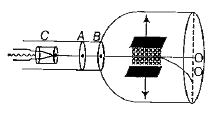Describe Thomson's experiment for determination of qm of an electron with necessary theory.
JJ Thomson was the first scientist who measured charge to mass ratio (q/m) of an electron.
When a narrow beam of charged particles are projected at a constant speed (v) across a magnetic field in a direction perpendicular to the field, the beam of particles experiences a force, which makes them move in a circular path.

Apparatus consists of a highly evacuated glass tube, fitted with electrodes shown above. Electrons are produced by heating a tungsten filament electrically. Electrons are made to accelerate and form a beam by passing through discs A and B. They are passed through electric and magnetic field. Finally, they fall on zinc sulphide screen. The electrons moving side ways are also directed towards the screen by applying a negative potential on a hollow cylinder (c) open on both sides surrounding the filament. Electrons are accelerated by applying a potential difference of above 1000 V between the filament and disc A. A further potential difference of 500 V is applied between the discs A and B. The arrangement focuses the beam to the hole of the disc B from where it is further proceeds to a straight line. When beam of electrons enters a magnetic field, it moves in a circular track. The force experienced by the electrons is
Fm=qvB
This magnetic field provides necessary centripetal force to an electron so that it follows a circular path.
i.e., Fm=Fe
qvB=mv2/r⇒qm=vBr
By putting values of v, B and r, value of q/m is determined.
Similar Questions
Describe an experiment to determine melting point of wax.
View SolutionIn Thomson's experiment for determining e/m the potential different between the cathod and the anod (in accelerating coloumns ) is same as that between the deflecting plates (in the regions of crossed field ) . If thep.d is doubled , by what factor should the magnetic field be increased to ensure that the electron beam remains undeflected
View Solution
Knowledge Check
JJ Thomson experiment revealed that
Aatoms are smallest entities of matterBatoms are round in shapeCatoms are not electrically neutralDatoms contain negatively charged particlesIn Thomson's method of determining e/m of electrons
AElectric and magnetic fields are parallel to electrons beamBElectric and magnetic fields are perpendicular to each other and perpendicular to electrons beamCMagnetic field is parallel to the electrons beamDElectric field is parallel to the electrons beamIn the experiments for determination of e /m of electrons by Thomson method electric and magnetic fields are
Aparallel and both are perpendicualr to the motion of the electronBboth mutually parallel and also parallel to the motion of the electronCboth mutually perpendicular and also perpendicular to the motion of the electronDboth mutually perpendicualr and have no relation with the motionof the electron
In Thomson.s experiment, prove that the ratio of charge to the mass (e/m) of an electron is given by :
em=12V.E2B2
where the terms have their usual meaning.
View SolutionElectrons which have been accelerated by a potential difference of 1000 V enter co-terminus electric and magnetic fields of strengths 20V/cm and 1 G respectively as in the Thomson's experiment. Estimate the e/m and the speed fo the electrons if they move undeviated through this system.
View SolutionAssertion (A),In the Thomson's e/m experiment of electrons, the specific charge of electrons is independent of natural of the discharge tube
Reason (R ): Charge of a body is quantized
View SolutionIn Thomson experiment of finding e/m for electrons beam of electrons is replaced by that of muons (particle with same charge as of electrons but mass 208 times that of electrons) no deflection condition in this case satisfied if
View SolutionIn Thomson experiment of finding e/m for electrons beam of electrons is replaced by that of muons (particle with same charge as of electrons but mass 208 times that of electrons) no deflection condition in this case satisfied if
View Solution
